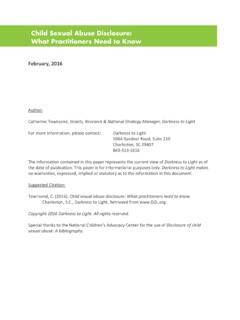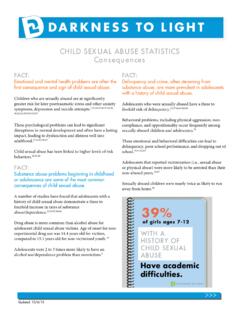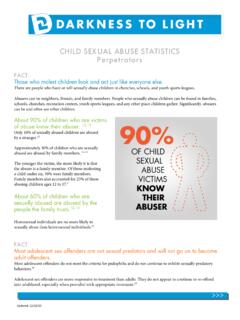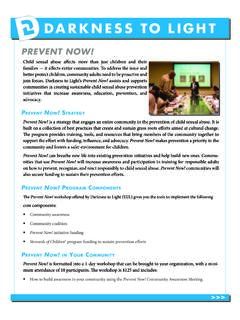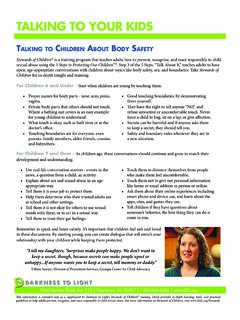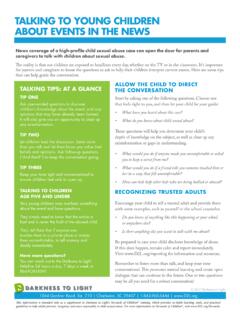Transcription of CHILD SEXUAL ABUSE STATISTICS - Darkness to Light
1 CHILD SEXUAL ABUSE STATISTICS The Issue of CHILD SEXUAL ABUSE What is CHILD SEXUAL ABUSE ? FACT: The definition of CHILD SEXUAL ABUSE is broader than most people realize. Often a traumatic experience for children and teens, CHILD SEXUAL ABUSE is a criminal offense punishable by law in many CHILD SEXUAL ABUSE includes: any SEXUAL act between an adult and a minor, or between two minors, when one exerts power over the forcing, coercing or persuading a CHILD to engage in any type of SEXUAL non-contact acts such as exhibitionism, exposure to pornography, voyeurism, and communicating in a sexualmanner by phone or is the magnitude of the problem? FACT: CHILD SEXUAL ABUSE is far more prevalent than most people realize. CHILD SEXUAL ABUSE is likely the most prevalent health problem children face with the most serious array About one in 10 children will be sexually abused before their 18th birthday*.1 About one in seven girls and one in 25 boys will be sexually abused before they turn 18*.
2 1 This year, there will be about 400,000* babies born in the that will become victims of CHILD SEXUAL abuseunless we do something to stop *Includes contact ABUSE onlyFACT: Identified incidents of CHILD SEXUAL ABUSE are declining, although there is no clear indication of a cause. The number of identified incidents of CHILD SEXUAL ABUSE decreased at least 47% from 1993 to ,4 FACT: Even with declining rates of SEXUAL ABUSE , the public is not fully aware of the magnitude of the problem. The primary reason is that only about 38% of CHILD victims disclose the fact that they have been ,6 Some never ,8 There are also privacy issues surrounding cases of CHILD SEXUAL ABUSE . For instance, public police reports donot name the victim, and most media concerns have a policy that precludes naming victims. FACT: Most people think of adult rape as a crime of great proportion and significance, and are unaware that children are victimized at a much higher rate than adults.
3 Nearly 70% of all reported SEXUAL assaults (including assaults on adults) occur to children ages 17 ,10 Youths have higher rates of SEXUAL assault victimization than do adults. In 2000, the rate for youths aged 12 to 17 was times higher than for adults. 53 44% of rapes with penetration occur to children under age 18. Victims younger than 12 accounted for 15% ofthose raped, and another 29% of rape victims were between 12 and 17. 10,11 Who are the perpetrators of CHILD SEXUAL ABUSE ? FACT: Those who molest children look and act just like everyone else. There are people who have or will sexually ABUSE children in churches, schools and youth sports leagues. Abusers can be neighbors, friends and family members. People who sexually ABUSE children can be found in families, schools, churches, recreation centers, youth sports leagues, and any other place children gather. Significantly, abusers can be and often are other children. About 90% of children who are victims of SEXUAL ABUSE know their ,13 Only 10% of sexually abusedchildren are abused by a Approximately 30% of children who are sexually abused are abused by family ,13 The younger the victim, the more likely it is that the abuser is a family member.
4 Of those molesting a childunder six, 50% were family members. Family members also accounted for 23% of those abusing childrenages 12 to About 60% of children who are sexually abused are abused by people the family ,13 Homosexual individuals are no more likely to sexually ABUSE children than heterosexual : Not everyone who sexually abuses children is a pedophile. CHILD SEXUAL ABUSE is perpetrated by a wide range of individuals with diverse motivations. It is impossible to identify specific characteristics that are common to all those who molest children. Situational offenders tend to offend at times of stress and begin offending later than pedophilic offenders. They also have fewer victims (often family), and have a general preference for adult Pedophilic offenders often start offending at an early age, and often have a large number of victims(frequently not family members).16 70% of CHILD sex offenders have between one and 9 victims, while 20% have 10 to 40 FACT: As many as 40% of children who are sexually abused are abused by older, or more powerful The younger the CHILD victim, the more likely it is that the perpetrator is a juvenile.
5 Juveniles are the offendersin 43% of assaults on children under age six. Of these offenders, 14% are under age Juveniles who commit sex offenses against other children are more likely than adult sex offenders to offend ingroups, to offend at schools, and to have more male victims and younger The number of youth coming to the attention of police for sex offenses increases sharply at age 12 andplateaus after age 14. Early adolescence is the peak age for youth offenses against younger A small number of juvenile offenders one out of eight are younger than age 12. Females constitute 7%of juveniles who commit sex FACT: Most adolescent sex offenders are not SEXUAL predators and will not go on to become adult offenders. Most adolescent offenders do not meet the criteria for pedophilia and do not continue to exhibit sexuallypredatory Adolescent sex offenders are more responsive to treatment than adults. They do not appear to continue to re-offend into adulthood, especially when provided with appropriate Risk Factors and Consequences Under what circumstances does CHILD SEXUAL ABUSE occur?
6 FACT: CHILD SEXUAL ABUSE often takes place under specific, often surprising circumstances. It is helpful to know these circumstances because it allows for the development of strategies to avoid CHILD SEXUAL ABUSE . 81% of CHILD SEXUAL ABUSE incidents for all ages occur in one-perpetrator/one- CHILD circumstances. Six to 11-year-old children are most likely (23%) to be abused in multiple-victim Most SEXUAL ABUSE of children occurs in a residence, typically that of the victim or perpetrator 84% forchildren under age 12, and 71% for children aged 12 to 17. 9 SEXUAL assaults on children are most likely to occur at 8 , 12 and between 3 and 4 For olderchildren, aged 12 to 17, there is also a peak in assaults in the late evening One in seven incidents of SEXUAL assault perpetrated by juveniles occurs on school days in the after-schoolhours between 3 and 7 , with a peak from 3 to 4 FACT: Commercial SEXUAL exploitation and internet sex crimes against children are a small and yet significant part of the overall problem.
7 In 2006, arrests for online youth victim cases constituted only of arrests for all sex crimes againstchildren. There were 615 arrests for online cases vs. 49,345 arrests for all sex crimes against 9% of all 10 to 17 year olds receive unwanted SEXUAL requests while on the Over a period of one year, one in 25 youth received an online SEXUAL solicitation where the solicitor tried tomake offline 23% of all 10 to 17 year olds experience unwanted exposure to CHILD SEXUAL ABUSE makes children more vulnerable to SEXUAL exploitation. More than 90% of children who arecommercially sexually exploited have been sexually abused in the About 75% of CHILD pornography victims are living at home when they are photographed. Parents are : Abusers often form relationships with potential victims and their families prior to the ABUSE . This is called "grooming." Grooming is a process by which an offender gradually draws a victim into a SEXUAL relationship and maintains that relationship in secrecy.
8 At the same time, the offender may also fill roles within the victim s family that make the offender trusted and valued. Grooming behaviors can include: Special attention, outings, and gifts Isolating the CHILD from others Filling the CHILD s unmet needs Filling needs and roles within the family Treating the CHILD as if he or she is older Gradually crossing physical boundaries, and becoming increasingly intimate/ SEXUAL Use of secrecy, blame, and threats to maintain controlWhat factors increase a CHILD s risk for SEXUAL ABUSE ? FACT: While no CHILD is immune, there are CHILD and family characteristics that significantly heighten or lower risk of SEXUAL ABUSE . The following risk factors are based on reported and identified cases of ABUSE : Family structure is the most important risk factor in CHILD SEXUAL ABUSE . Children who live with two marriedbiological parents are at low risk for ABUSE . The risk increases when children live with step-parents or a single Children living without either parent (foster children) are 10 times more likely to be sexually abused thanchildren that live with both biological parents.
9 Children who live with a single parent that has a live-in partner are at the highest risk: they are 20 times more likely to be victims of CHILD SEXUAL ABUSE than children living with both biological Gender is also a major factor in SEXUAL ABUSE . Females are five times more likely to be abused The age of the male being abused also plays a part. 8% of victims aged 12 to 17 are male. 26% of victims under the age of 12 are Age is a significant factor in SEXUAL ABUSE . While there is risk for children of all ages, children are mostvulnerable to ABUSE between the ages of seven and median age for reported ABUSE is nine years However, more than 20% of children are sexually abused before the age of Race and ethnicity are an important factor in identified SEXUAL ABUSE . African American children have almosttwice the risk of SEXUAL ABUSE than white children. Children of Hispanic ethnicity have a slightly greater risk than non-Hispanic white The risk for SEXUAL ABUSE is tripled for children whose parent(s) are not in the labor Children in low socioeconomic status households are three times as likely to be identified as a victim of Children who live in rural areas are almost two times more likely to be identified as victims of CHILD Children who witness or are the victim of other crimes are significantly more likely to be sexually : Family and acquaintance CHILD SEXUAL ABUSE perpetrators have reported that they look for specific characteristics in the children they choose to ABUSE .
10 Perpetrators report that they look for passive, quiet, troubled, lonely children from single parent or Perpetrators frequently seek out children who are particularly trusting Find new and work proactively toestablish a trusting relationship before abusing Not infrequently, this extends to establishing a trusting relationship with the victim s family as What are the immediate consequences of CHILD SEXUAL ABUSE ? FACT: Emotional and mental health problems are often the first consequence and sign of CHILD SEXUAL ABUSE . Children who are sexually abused are at significantly greater risk for later posttraumatic stress and otheranxiety symptoms depression and suicide ,23,24,35,36,37,38,39,40,41,42,49,50,51, 52,53 These psychological problems can lead to significant disruptions in normal development and often have alasting impact, leading to dysfunction and distress well into , 42,43,44,45 Behavioral problems, including physical aggression, non-compliance, and oppositionality occur frequentlyamong sexually abused children and ,54,111,112 CHILD SEXUAL ABUSE has been linked to higher levels of risk ,47,48 FACT: SEXUAL behavior problems and over-sexualized behavior are a very common consequence of CHILD SEXUAL ABUSE .


